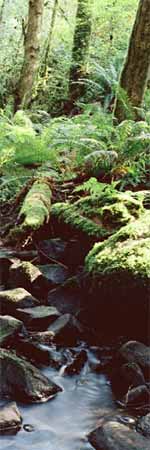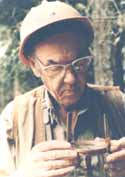The History of Hopkins
In 1975, the creek beavers disappeared and they changed the name to “Grouse Hollow”. When they bought it, the tree farm was stocked with scruffy fir, cedar, alder, and brush left after earlier loggings. Pop’s opening timber account listed a total of 300 MBF (50 MBF old growth Douglas-fir, 100 MBF second growth Douglas-fir, 50 MBF cedar, and 100 MBF alder). Large areas of the tree farm were rocky soil. It was loaded with poison oak. Boomers abounded. Pop could see that it had potential, so he set out to develop that potential.
Pop Kept Diaries
Pop first made it his business to become thoroughly familiar with the place, all the while considering what the final road system would be. Through the years, the diaries he kept of his tree farm activities document his frustrated attempts at boomer control through trapping, his work at poison oak, tansy, blackberry and other brush control, release work, pruning, planting, road maintenance, running and clearing the lines, as well as managing timber sales.


First Timber Sale
In 1966, he made his first timber sale: 70 MBF of scattered old growth Douglas-fir for $1,400 and put the money back in roads. Over the next 20 years, he took out an additional 455 MBF, plus some salvage and firewood sales. The largest timber sale, 173 MBF, was in 1976 when four areas were clearcut. These areas were replanted in 1977 – they include the young plantation along the road. Pop’s records show that over the years he planted 21,300 trees at Grouse Hollow. Not all of them grew, of course. For example, in 1981, he noted that, of the 1,600 he had planted that year, 5 percent were dead of drought and 25-30 percent had disappeared, presumably eaten by boomers.
Through all of the years, Mother was an enthusiastic supporting partner, and the entire family enjoyed Grouse Hollow where we picnicked, cut Christmas trees and greenery, and gathered blackberries, apples, and mushrooms.
Mother Continues Legacy
After Pop died in September of 1989, Mother, who was concerned that development pressures might force Grouse Hollow into a subdivision at some time in the future, decided that she would like to turn Grouse Hollow over to some agency or group that would keep it as forest. As she explored a number of options, it gradually became clear to her that it would best honor Pop’s commitment to sustainable forestry if it remained as an operating tree farm where others could come to learn about forests and forest management. She conferred with Ken Everett of the Clackamas County Farm Forestry Association, who was enthusiastic, as was Mike Bondi of the Extension Service.
Through enormous inputs of energy and time by the two of them, and the support of the CCFFA and a large and dedicated group of people, the necessary non-profit corporation, Forests Forever, was established in September, 1990 and Mother deeded Grouse Hollow to it. Mother retained an income interest for her, and after her death, for my sister and me. After our deaths, all income will belong to Forests Forever, Inc.
All future use of Grouse Hollow must comply with the restrictions in the deed, unless changes are authorized by court action. These restrictions provide that the property must be used for one or more of the listed purposes: Retention as forest land, research on intensive forest management, conservation of the forest management, conservation of the forest ecosystem, education of the public, and/or public access. It pleases the family enormously that, through the work of many people, all of those purposes are being met.
Written by Connie Battaile, the daughter of the late Margaret and Howard Hopkins, is a Master Woodland Manager and resides in Southern Oregon. This article was previously published in the August 1993 issue of the Forest-Tree Leader.
